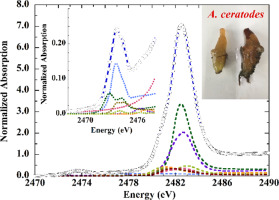当前位置:
X-MOL 学术
›
J. Inorg. Biochem.
›
论文详情
Our official English website, www.x-mol.net, welcomes your
feedback! (Note: you will need to create a separate account there.)
Biological sulfur in the blood cells of Ascidia ceratodes: XAS spectroscopy and a cellular-enzymatic hypothesis for vanadium reduction in the ascidians.
Journal of Inorganic Biochemistry ( IF 3.8 ) Pub Date : 2020-01-07 , DOI: 10.1016/j.jinorgbio.2019.110991 Patrick Frank 1 , Robert M K Carlson 2 , Elaine J Carlson 3 , Britt Hedman 4 , Keith O Hodgson 1
Journal of Inorganic Biochemistry ( IF 3.8 ) Pub Date : 2020-01-07 , DOI: 10.1016/j.jinorgbio.2019.110991 Patrick Frank 1 , Robert M K Carlson 2 , Elaine J Carlson 3 , Britt Hedman 4 , Keith O Hodgson 1
Affiliation

|
Two samples of living blood cells and of cleared blood plasma from the Phlebobranch tunicate Ascidia ceratodes from Bodega Bay, California, and one of fresh Henze solution from A. ceratodes of Monterey Bay, California, have been examined using sulfur K-edge x-ray absorption spectroscopy (XAS). Biological sulfur included sulfate esters, sulfate and bisulfate ions, benzothiazole, thianthrene, epi-sulfide, thiol and disulfide. Glutathione dominated reduced sulfur, from which an average intracellular Voltage of -0.21 V was calculated. Sulfate-bisulfate ratios yielded blood cell pH values of 2.0 and 2.8. Total blood cell [sulfur] was 373±9 mM or 296±73 mM from BaSO4 gravimetry. Two plasma samples (pH 6.9 or 7.0; [S] = 33±6 mM or 26±4 mM) were dominated by sulfate and disulfide. Fresh Henze solution evidenced a sulfur inventory similar to blood cells, with calculated pH = 2.7. A V(III)-sulfonate fraction varied systematically with intracellular pH across six independent blood cell samples, implying a vanadium mobilization pathway. Bodega Bay and Monterey Bay A. ceratodes appear to maintain alternative suites of low-valent sulfur. The significance of the vanabins to vanadium metabolism is critically examined in terms of known protein - V(IV) biochemistry. Finally, a detailed hypothesis for the reduction of [VO4]3- to V(III) in ascidians is introduced. A vanadium oxido-reductase is proposed to span the signet ring membrane and to release V(III) into the inner acidic vacuole. The V(V) to V(III) reduction is predicted require an inner-sphere mechanism, a thiol reductant, 7-coordinate V(III), a biologically accessible Voltage, and proton-facilitated release of V(III).
中文翻译:

海鞘血细胞中的生物硫:XAS 光谱和海鞘中钒还原的细胞酶假说。
使用硫 K 边 X 射线对来自加利福尼亚州博德加湾的白蛉被囊动物 Ascidia ceratodes 的活血细胞和澄清血浆样本以及来自加利福尼亚州蒙特利湾的 A. ceratodes 的新鲜 Henze 溶液进行了检查吸收光谱(XAS)。生物硫包括硫酸酯、硫酸根和硫酸氢根离子、苯并噻唑、噻蒽、环硫化物、硫醇和二硫化物。谷胱甘肽主导还原硫,由此计算出平均细胞内电压为-0.21 V。硫酸盐-硫酸氢盐比率产生的血细胞 pH 值分别为 2.0 和 2.8。根据 BaSO4 重量分析,总血细胞[硫]为 373±9 mM 或 296±73 mM。两个血浆样品(pH 6.9 或 7.0;[S] = 33±6 mM 或 26±4 mM)主要由硫酸盐和二硫化物组成。新鲜 Henze 溶液的硫含量与血细胞相似,计算得出的 pH = 2.7。六个独立血细胞样本中 AV(III)-磺酸盐分数随细胞内 pH 值发生系统变化,这表明存在钒动员途径。博德加湾和蒙特利湾角犀似乎保留着替代性的低价硫。根据已知的蛋白质 - V(IV) 生物化学,对钒代谢的重要性进行了严格的研究。最后,介绍了海鞘中 [VO4]3- 还原为 V(III) 的详细假设。钒氧化还原酶被提议跨越印戒膜并将 V(III) 释放到内部酸性液泡中。V(V) 到 V(III) 的还原预计需要内球机制、硫醇还原剂、7 配位 V(III)、生物可访问电压以及质子促进的 V(III) 释放。
更新日期:2020-01-07
中文翻译:

海鞘血细胞中的生物硫:XAS 光谱和海鞘中钒还原的细胞酶假说。
使用硫 K 边 X 射线对来自加利福尼亚州博德加湾的白蛉被囊动物 Ascidia ceratodes 的活血细胞和澄清血浆样本以及来自加利福尼亚州蒙特利湾的 A. ceratodes 的新鲜 Henze 溶液进行了检查吸收光谱(XAS)。生物硫包括硫酸酯、硫酸根和硫酸氢根离子、苯并噻唑、噻蒽、环硫化物、硫醇和二硫化物。谷胱甘肽主导还原硫,由此计算出平均细胞内电压为-0.21 V。硫酸盐-硫酸氢盐比率产生的血细胞 pH 值分别为 2.0 和 2.8。根据 BaSO4 重量分析,总血细胞[硫]为 373±9 mM 或 296±73 mM。两个血浆样品(pH 6.9 或 7.0;[S] = 33±6 mM 或 26±4 mM)主要由硫酸盐和二硫化物组成。新鲜 Henze 溶液的硫含量与血细胞相似,计算得出的 pH = 2.7。六个独立血细胞样本中 AV(III)-磺酸盐分数随细胞内 pH 值发生系统变化,这表明存在钒动员途径。博德加湾和蒙特利湾角犀似乎保留着替代性的低价硫。根据已知的蛋白质 - V(IV) 生物化学,对钒代谢的重要性进行了严格的研究。最后,介绍了海鞘中 [VO4]3- 还原为 V(III) 的详细假设。钒氧化还原酶被提议跨越印戒膜并将 V(III) 释放到内部酸性液泡中。V(V) 到 V(III) 的还原预计需要内球机制、硫醇还原剂、7 配位 V(III)、生物可访问电压以及质子促进的 V(III) 释放。











































 京公网安备 11010802027423号
京公网安备 11010802027423号